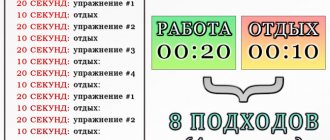A competent program for working out muscles is the basis of training progress.
It is this that will ensure intensive muscle growth and a balanced load.
In this article we will analyze the features of various programs, effective exercises and the specifics of training.
Let's draw up a rough training plan for men and women for different muscle groups.
Rules for creating your own weekly program
The ability to create an individual program for sports activities is a key characteristic of an advanced athlete and the dream of any beginner.
Preparation of such a program includes the following steps:
- write a basic training plan. First there should be a warm-up (about 10 minutes), 2 exercises for any of the main muscle groups (legs, back, chest), 3 exercises for secondary muscles (shoulders, biceps, triceps), and a cool-down (5 minutes). If you are focused on losing excess weight, you need to devote 20 minutes to cardio after strength training;
- set the main goal and objectives. The weakest muscle groups (especially if they are secondary) can be trained 2 times a week with a break of a couple of days for proper rest and recovery (for example, on Monday and Thursday);
Note! To work out your abs, you can include 3 sets of planks right into your warm-up, and leg raises or another similar exercise for several muscle groups during your cool-down.
- choose suitable exercise options. To the first set of exercises (load on large muscle groups), it is recommended to add basic loads or their variations on special exercise machines. You need to add isolated loads to the combination of small muscle exercises, changing them regularly to check the effectiveness. The selection of exercises largely depends on what exercise equipment and auxiliary devices you have in your home and gym;
- determine the number of approaches and repetitions. The total number of sets for each large muscle group should be 12-15 (i.e. 3 exercises of 4 sets or 4 exercises of 3-4 sets). The first set should use a fairly heavy weight and a minimum number of repetitions (from 8 to 12), while the second set should use a working weight and an increased number of repetitions (12 to 15).
Be sure to check out: Split program: training to pump up muscles with proven effectiveness Monthly training program: rules for drawing up a plan and sets of exercises Detailed training program with your own weight at home Effective training program for gaining muscle mass 3 times a week
Nutrition training system and daily schedule. How to create the right routine?
If you, for example, are a night owl, then playing sports will be important for you in the late afternoon.
To create a necessary and useful daily routine for yourself, you should first of all pay attention to what you have at the moment. Consider your usual day, lesson plan.
Very often, every person plans a lot of things for the next day in the evening, but not everyone manages to complete everything within the planned time frame. As a result, you get tired faster, and there is not enough time for proper nutrition and sleep.
Proper nutrition for weight loss is a very important point. Pay attention to what you eat, when you eat it, and how much you eat. Physical activity must be included in your regimen. We won’t talk about the benefits of this factor for the body, because everyone already knows that sport is life, especially when pursuing the goal of losing weight.
Taking into account the individual biorhythm, which was mentioned earlier, it is necessary to correctly create a daily routine, so that there is time for sports activities, and for the necessary nutrition, and for healthy sleep. So, your daily regimen for losing weight should include the following points:
- Rise and fall. Put your body into a routine so that you fall asleep and wake up at approximately the same time every day, except weekends. This way you can activate all your vital resources and lose excess weight faster.
- Charger. Since childhood, we have been told about the benefits of morning exercises, so we should not neglect this opportunity to improve the health of the body. Physical activity, which takes no more than 15 minutes, will help you wake up faster, add energy for the whole day and increase your appetite.
- Breakfast. It is not recommended to skip a morning meal, because it is a way to improve the digestive system, an accelerator for metabolism, a boost of strength and energy, and an effective method for losing weight. Try to consume healthy foods at the same time: muesli, whole grain cereals, yogurt, fresh juices, grapefruit, etc.
- Meals for the day. When planning your daily routine, include 3 main meals and 2 snacks, with nutritionists recommending 2-3 hours between meals. For lunch you can prepare a first course, and for dinner - a salad with boiled meat/fish. Eliminate fatty and unhealthy foods from your diet, as well as sweets and flour. Do not eat later than 3-4 hours before bedtime.
- Physical exercise. In addition to the mandatory morning exercises, losing weight requires you to devote time to other physical activities. You can go to the gym or swimming pool after work, and if this is not possible, do yoga or aerobics at home for half an hour. Spend time in the fresh air more often, preferably actively, because it is not only physical exercise, but also benefits for the whole body.
Sample lesson plan for women
Exercises for weight loss
Strength training with weights (most often called “base” by professionals) burns a huge amount of calories. This result is quite natural: such exercises require enormous energy expenditure. However, it will not be possible to constantly do basic exercises if your body is experiencing a calorie deficit (calorie restrictions are inevitable in the process of losing weight). In this case, they can exhaust the body and contribute to the appearance of overtraining. Strength loads during weight loss should be used in doses.
And long-term loads at an average rhythm (for example, running, aerobic exercises or high-repetition exercises with light weights) do not load the losing weight body as intensely as strength training, so their quantity should prevail. The number of workouts per week is 4-5.
Note ! There is a special concept - “heart rate zone for fat burning” (approximately 70% of peak heart rate). It is believed that with such a pulse, the body burns subcutaneous fat as intensively as possible.
Example program:
- Warm-up: cardio exercise (30 minutes).
- Smith Squats: 3 sets of 12 reps (light weight).
- Lunges with weights: 3-4 sets of 15 times for each leg separately.
- Hyperextension on a bench: 3 sets of 15 repetitions.
- Curls with dumbbells (“hammers”): 4 sets of 15 reps.
- Crunches: 4 sets of 15 times.
- Roman chair sit-ups: 3-4 sets of 15 reps.
- Cool down: cardio (at least 25 minutes).
Exercises for relief
Relief training involves 5-6 workouts per week, but all of them should be strength training. The optimal option is 3 strength exercises and 2 cardio (running at a moderate pace, jumping rope, swimming). This version of the relief program will allow you to achieve the best results.
The number of repetitions should vary from 12 to 15 times in 1 set. The weight used is average (depending on the individual level of physical fitness). The weight is selected in such a way that the athlete can do 12 repetitions while maintaining the correct technique.
There are no clear recommendations regarding the number of approaches in relief training - you should focus on your body and the planned list of exercises. For example, if you decide to perform 8 exercises in one session, stop at the minimum number of sets (3). With less variety of loads, gradually increase the total number of approaches.
Example program:
- Warm-up: cardio (15 minutes).
- Raises with weights: 4 sets of 15 reps.
- Lifting dumbbells to the shoulders: 3-4 sets of 12-15 times.
- Lat Pulldown: 4 sets of 12 reps.
- Push-ups: 3 sets of 12 reps.
- Crunches (incline bench): 4 sets of 12 reps.
- Cool down: cardio (at least 10 minutes).
Massive exercises
Gaining muscle mass is simply impossible without the use of basic multi-joint exercises. It is important to note that such training excludes a large number of repetitions, light weights and long-term cardio training - all this simply will not allow the muscles to increase in volume.
In mass training, you should use a minimum number of repetitions (8-10) and sets (3) with a large working weight (determined individually). The number of workouts per week is 2-3.
Example program:
- Warm-up: cardio exercise (10 minutes).
- Deadlift: 3 sets of 8-10 reps.
- Squats with weights: 3 sets of 10 reps.
- Leg press: 3 sets of 8 repetitions.
- Weighted lunges: 3 sets of 8-10 reps for each leg.
- Lying leg curls: 3 sets of 10 reps.
Weight training schedule
The goal of training during this period is hypertrophy of muscle fibers, so the training system must create adequate muscle stress and allow the body to restore it. On the other hand, in addition to contractile proteins, you also train energy, the central nervous system, the cardiovascular system and, in general, force the body to comprehensively adapt to your training program. In this regard, the training schedule requires mandatory microperiodization, and at a more advanced level, even macroperiodization. In practice, this is expressed in the alternation of “light”, “medium” and “heavy” training, as well as training complexes. The difficulty of workouts varies based on the muscle and non-muscle qualities they train.
The duration of training should not exceed 60 minutes, but this time does not include warm-up. That is, you come to the gym, warm up, stretch, warm up, all this takes about 10-20 minutes. After this, you place an empty bar on the rack and begin to perform the first approach at a very slow pace - from this moment you count down 60 minutes. You can often hear that this time is not enough, that “you can’t do anything in 60 minutes.” Is it so? Let's count!
Let's say you train two muscle groups during a workout and perform 15 working approaches for each, in total you do as many as 30 approaches. Before each exercise, you do 2 warm-up approaches, between which, of course, there is no rest. Each approach takes you from 30 to 50 seconds. So, 30 sets of 50 seconds is 25 minutes, rest between each set of 60 seconds is another 30 minutes, warm-up sets take from 5 to 10 minutes. In total , we get a maximum of 65 minutes of training.
The best time to train depends on what type of muscle fiber you are training. Since by mass training we mean training both oxidative and fast muscle fibers, it is optimal to conduct such training in the evening. The bottom line is that in the afternoon the body temperature is higher than in the morning, and this has a beneficial effect on the work of high-threshold fast muscle fibers. In addition, in the evening the hormonal background is more favorable: there is more testosterone and less cortisol. However, if you are a “morning person”, that is, you are used to being awake during the day, then, most likely, the optimal training time for you will be 3-4 o’clock in the afternoon, while for a “night owl” - 7-8 o’clock in the evening.
The training schedule in the gym for gaining muscle mass may vary depending on how you split up the training of different muscle groups. If you train 1 large and 1 small muscle group per workout, and use microperiodization of large muscle groups, then you can train every other day. It is recommended to group the chest with the biceps, the back with the triceps, and the legs with the shoulders, since these muscles are antagonistic.
If your training schedule involves training large muscle groups separately from small ones, then you will have to train more often, so it is important to group consecutive workouts so that training the previous muscle group does not interfere with training the next one. For example , you can train your legs on Monday, your chest on Tuesday, rest on Wednesday, train your back on Thursday, shoulders on Friday, and arms on Saturday. You can combine arm and shoulder training, or add middle and rear delt training to your chest workout, and front delt training to your back workout.
Strength training schedule
The goal of strength training is the development of glycolytic and high-threshold fast muscle fibers, as well as a method of energy supply to muscles due to the breakdown of creatine phosphate. You can train both muscle fibers on average once every two weeks, so between such workouts you should also pay attention to oxidative fibers. In other words, a strength training schedule also involves microperiodization, and more complex than the one you use when gaining muscle mass. Since power schemes differ in specialization, we will not consider a specific scheme here; you can familiarize yourself with them in the training programs .
The duration of training should also not exceed 60 minutes, since after this time the level of testosterone begins to decrease and cortisol increases, so catabolic processes prevail over anabolic ones. In this regard, the strength training schedule ideally involves splitting the training into 2 days. The bottom line is that to restore creatine phosphate, you need 5 to 10 minutes of rest between sets, so 5-6 sets of a basic exercise can take up the entire workout. If you are not a professional powerlifter, then this is of no use to you; you can perform one basic exercise and two auxiliary exercises per workout, although the effectiveness of such training, of course, will be lower.
The best time for training , of course, is in the evening for the reasons stated above. But, in addition to increased testosterone levels and increased strength indicators, by training in the evening, you also reduce the likelihood of injury. The reduced risk of injury is again associated with body temperature. If your biorhythms do not allow you to train in the evening, then, of course, it is much better to train in the morning, since lethargy neutralizes all the benefits that evening training provides. In addition, neuromuscular communication is better in the morning, since the brain is not yet clogged from sleep. If you have a flexible schedule, then this is not a problem, since bad training is better than no training!
scheme looks something like this: training the glycolytic muscle fibers of one large muscle group, then training the oxidative muscle fibers of another, followed by a third training of the high-threshold fast muscle fibers of the third. Between these workouts there may be other auxiliary workouts. In fact, strength programs are really very different from each other; there are a lot of techniques that allow you to achieve results in different exercises. There are athletes whose chest lags behind, then they pay more attention to it, others have a weak point - their back, so we will analyze specific training programs separately. Now it is important to understand that training for strength is training very special muscle qualities that allow you to develop the maximum speed of contraction of muscle fibers in a very short time, and there are many of these qualities, and their recovery time varies, so the strength training schedule necessarily includes microperiodization .
Drying training schedule
The goal of training in this case is to reduce subcutaneous fat and preserve muscle tissue. In fact, it is not training that is responsible for fat reduction, but diet, since the body utilizes fat when it does not have enough calories to cover its energy costs. If you are planning to lose weight, then we recommend you a carbohydrate diet , since, in addition to the fat-burning effect, it also helps maintain strength indicators. Exercise can really help you lose weight, but it can only help because fat is broken down during exercise. Moreover, there are methods to speed up fat reduction at a certain point, which you can read more about here. As for the training schedule, it should be divided into anaerobic and aerobic training.
The duration of both aerobic and anaerobic training should not exceed 40 minutes. The bottom line is that in conditions of a lack of nutrients, catabolic processes begin faster, and if, while gaining muscle mass, you can level them out by eating fast carbohydrates, then in this case you are very limited in your capabilities. So don't take unnecessary risks! In general, we recommend using training to maintain muscle mass rather than to break down fat. If you are counting on the reduction of fat deposits from sports, then this is not effective. Dietary restrictions will have a much greater effect, since whether you will lose weight or not depends on the ratio of calories and energy consumption, and increasing energy consumption is more difficult than reducing calorie intake. For example, 100g of rice contains 290 Kcal, and in 1 hour of jogging you will spend 600 Kcal. It’s clear that running for an hour is more difficult than eating 200 grams of rice per day less.
The best time to exercise depends on whether it is anaerobic or aerobic. If your training schedule includes both types of training, then there should be at least 6 hours of rest between them. It is best to run in the morning and train in the evening. Don’t be surprised by this advice, because although sport does not burn fat, it breaks it down, as a result of which lipid metabolism occurs more easily. In addition, we are talking about the fact that diet is the main thing in losing weight, but when you combine diet with sports, the process is much more fun. However, if you are ready to lose weight over a longer period of time and want to preserve muscle mass as much as possible, then you should abandon aerobic training, leaving only anaerobic training in your training schedule.
schemes for “cutting”: 1 – for natural bodybuilders, 2 – for athletes who indulge in pills. If you do not take any androgenic drugs, then you should leave your usual training split for weight, slightly reducing its volume in order to destroy muscle cells less, because it will be more difficult for the body to restore them in conditions of caloric deficiency. If you indulge in anabolic steroids, then you can allow yourself to perform exercises in a large number of repetitions of 15-20, use supersets and stuff like that. However, even if you use steroids, then by exercising according to the classical scheme, you will still preserve your muscles better. You can also add jogging or race walking to your training schedule.
Effective sets of exercises for men
Exercises for weight loss
The training program for men who want to lose weight should be as intense and quite dense as possible. To get noticeable results, you need to exercise 4-5 times a week, and the duration of each workout should be at least 60 minutes + cardio (at least 30 minutes per day). 3-4 classes per week are recommended.
Such an intense schedule will help create an active calorie expenditure and speed up the process of breaking down fat in the body.
Example of a lesson program:
- Warm-up: cardio exercise (at least 30 minutes).
- Dumbbell bench press: 3 sets of 12 repetitions.
- Push-ups on the horizontal bar: 3 sets of 12-15 times.
- Dumbbell raises: 3-4 sets of 15 repetitions.
- Incline crunches: 4 sets of 15 reps.
- Cool down: cardio (10 minutes).
Exercises for relief
Relief exercises for men should consist of basic exercises (aimed at maintaining muscle volume) and a sufficient number of isolated exercises (allowing to improve muscle relief).
Each strength training should focus on working 1-2 muscle groups. The training plan drawn up should not take much time; the optimal duration of the lesson is 1 hour. To work out the relief, the principle of pumping is often used - exercises are performed with high frequency and multiple repetitions. Training frequency – 4-5 times a week.
Sample program:
- Warm-up: cardio (15 minutes).
- Leg curls in the simulator: 4 sets of 15 repetitions.
- Leg extensions in a special machine: 4 sets of 15 repetitions.
- Barbell squats: 3-4 sets of 12-15 reps.
- Side lunges: 4 sets of 12 reps.
- Cool down: cardio (at least 10 minutes).
Mass training
For the growth of muscle mass, constant progression of weight (weights in exercises) and a small number of repetitions (about 8 times) are most important. For optimal recovery of the entire body, the break between workouts should last at least 2 days (2 sessions per week).
Important ! Do not chase the number of repetitions with heavy weights - more than 12 repetitions per set will train endurance, and not contribute to weight gain.
Example program:
- Warm-up: cardio exercise (10 minutes).
- Bench press: 3 sets of 8 reps.
- Raises with weights: 3 sets of 10 repetitions.
- Barbell lifts: 3 sets of 8-10 reps.
- Arm curls (“hammers”): 3 sets of 8 times.
Strength exercises
Maximum strength indicators are developed by performing basic exercises with heavy weights. The number of approaches should be 3-5 for one exercise.
Note! There is no need to do a set with the maximum possible weight right away - this will create a lot of stress for the body. Increase the weight gradually, and use the first set of any exercise to warm up the target muscles.
For an intense workout, use a combination of compound weight exercises along with isolation exercises on cable machines.
Be prepared for long workouts (about 2 hours or more). This specificity of the exercises is due to the fact that after each approach a long rest is required - about 5 minutes. In this case, the effectiveness of training will be noticeable only with sufficient muscle rest. Also, do not forget about cardio loads before each strength training: 5-10 minutes of running at medium speed. The frequency of training is at least 2 times a week (rest after each – 36-48 hours).
Indicative lesson plan for strength:
- Warm up: cardio (at least 10 minutes).
- Barbell press (close grip): 4 sets of 8 reps.
- Military press: 3-4 sets of 8 reps.
- Barbell row (incline position): 4 sets of 8 reps.
- Dumbbell shrugs: 3 sets of 10 reps.
- Cool down: cardio (at least 10 minutes).
Training schedule for beginners
The most important factor regulating the quantity, quality, duration and volume of training is the goal. The most important goal of novice athletes is to prepare their body for future training in the gym. The first 3-4 months should be devoted to building the foundation! If you immediately start chasing weights, jumping at different training programs and exercises without creating a preliminary base, then the period of adaptation of the body will take a very long time. Most likely, you will not see results in the first six months, and after a year, you will stop playing sports altogether. The reason for this is incorrectly set priorities! Therefore, do not run ahead of the locomotive, making mistakes that can be avoided.
The muscles, central nervous system, neuromuscular connection , as well as the respiratory, cardiovascular and other systems of the body are still completely unprepared, so it is optimal during this period to exercise often, but not much. The schedule should consist of circuit training every other day. During this period, large muscle groups should be trained with basic exercises. You can find the optimal training program here . The duration of each workout should not exceed 40 minutes, so you should rest no more than 60 seconds between sets. It is strictly forbidden to progress the load! Moreover, you should work with a weight that is light for you. The technique of performing the exercises is ideal. You can find the rest of the training principles here.











